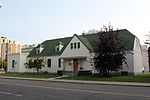Fort Edmonton
Fort Edmonton (also named Edmonton House) was the name of a series of trading posts of the Hudson's Bay Company (HBC) from 1795 to 1914, all of which were located on the north banks of the North Saskatchewan River in what is now central Alberta, Canada. It was one of the last points on the Carlton Trail, the main overland route for Metis freighters between the Red River Colony and the points west and was an important stop on the York Factory Express route between London, via Hudson Bay, and Fort Vancouver in the Columbia District. It also was a connection to the Great Northland, as it was situated relatively close to the Athabasca River whose waters flow into the Mackenzie River and the Arctic Ocean. Located on the farthest north of the major rivers flowing to the Hudson Bay and the HBC's shipping posts there, Edmonton was for a time the southernmost of the HBC's forts. From 1795 to 1830 it was located in four successive locations. Prior to 1821 each location was paired with a Fort Augustus of the North West Company (NWC). The fifth and final Fort Edmonton, 1830–1914, was the one that evolved into present-day Edmonton. Fort Edmonton was also called Fort-des-Prairies, by French-Canadians trappers and coureurs des bois, and amiskwaskahegan or "Beaver Hills House" in Cree, the most spoken Indigenous language in the region during the 19th century.In the late 18th century, the HBC, established in 1670, was in fierce competition with the NWC for the trade of animal furs in Rupert's Land. As one company established a fur trading post, the other would counter by building its post in close proximity or even farther upstream. Expansion up the Saskatchewan River was heated in the 1790s.
Excerpt from the Wikipedia article Fort Edmonton (License: CC BY-SA 3.0, Authors).Fort Edmonton
Fortway Drive NW, Edmonton Central Core
Geographical coordinates (GPS) Address Nearby Places Show on map
Geographical coordinates (GPS)
| Latitude | Longitude |
|---|---|
| N 53.531944444444 ° | E -113.50666666667 ° |
Address
Kwakiutl Totem Pole
Fortway Drive NW
T5K 2C3 Edmonton, Central Core
Alberta, Canada
Open on Google Maps









